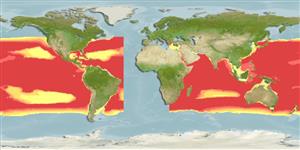Preferred temperature (Referencia
123201): 6.9 - 14.6, mean 9.9 °C (based on 728 cells).
Phylogenetic diversity index (Referencia
82804): PD
50 = 0.5000 [Uniqueness, from 0.5 = low to 2.0 = high].
Bayesian length-weight: a=0.00155 (0.00078 - 0.00308), b=3.11 (2.92 - 3.30), in cm total length, based on LWR estimates for this species & (Sub)family-body (Ref.
93245).
Nivel trófico (Referencia
69278): 4.2 ±0.7 se; based on size and trophs of closest relatives
Resiliencia (Referencia
120179): Medio, población duplicada en un tiempo mínimo de 1.4-4.4 años (Assuming tmax>3).
Fishing Vulnerability (Ref.
59153): Low vulnerability (10 of 100).
🛈
Nutrients (Ref.
124155): Calcium = 43.3 [14.1, 136.2] mg/100g; Iron = 0.411 [0.138, 1.304] mg/100g; Protein = 15.8 [12.7, 18.3] %; Omega3 = 0.125 [0.033, 0.402] g/100g; Selenium = 16.9 [5.0, 48.2] μg/100g; VitaminA = 39.7 [4.3, 330.3] μg/100g; Zinc = 0.513 [0.270, 1.026] mg/100g (wet weight);
